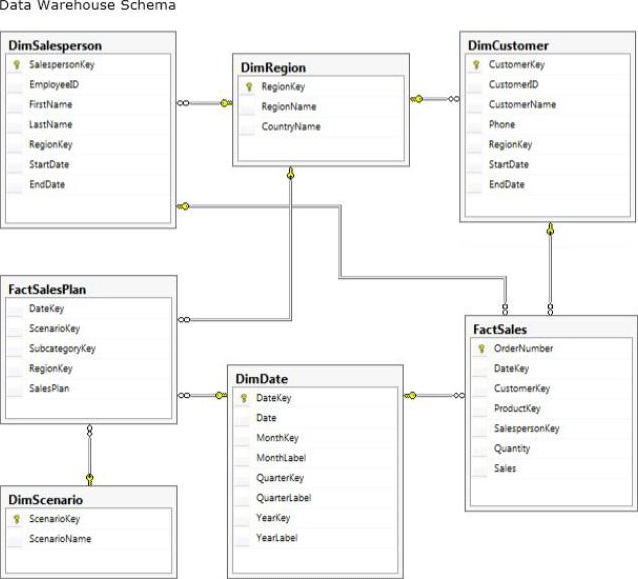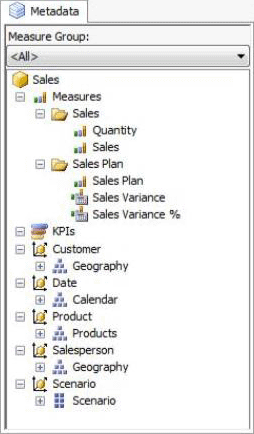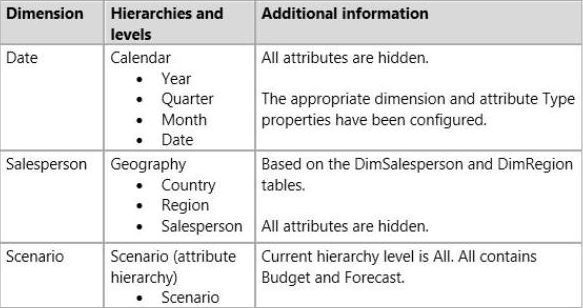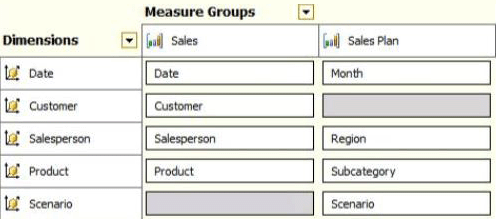Topic 1, Tailspin Toys Case A
Background
You are the business intelligence (BI) solutions architect for Tailspin Toys.
You produce solutions by using SQL Server 2012 Business Intelligence edition and Microsoft SharePoint Server 2010 Service Pack 1 (SP1) Enterprise edition.
Technical Background
Data Warehouse
The data warehouse is deployed on a SQL Server 2012 relational database.
A subset of the data warehouse schema is shown in the exhibit. (Click the Exhibit button.)

The schema shown does not include the table design for the product dimension.
T he schema includes the following tables:
– FactSalesPlan table stores data at month-level granularity. There are two scenarios: Forecast and Budget.
-The DimDate table stores a record for each date from the beginning of the company’s operations through to the end of the next year.
– The DimRegion table stores a record for each sales region, classified by country. Sales regions do not relocate to different countries.
– The DimCustomer table stores a record for each customer.
– The DimSalesperson table stores a record for each salesperson. If a salesperson relocates to a different region, a new salesperson record is created to support historically accurate reporting. A new salesperson record is not created if a salesperson’s name changes.
– The DimScenario table stores one record for each of the two planning scenarios.
All relationships between tables are enforced by foreign keys. The schema design is as denormalized as possible for simplicity and accessibility. One exception to this is the DimRegion table, which is referenced by two dimension tables.
Each product is classified by a category and subcategory and is uniquely identified in the source database by using its stock-keeping unit (SKU). A new SKU is assigned to a product if its size changes. Products are never assigned to a different subcategory, and subcategories are never assigned to a different category.
Extract, transform, load (ETL) processes populate the data warehouse every 24 hours.
ETL Processes
One SQL Server Integration Services (SSIS) package is designed and developed to populate each data warehouse table. The primary source of data is extracted from a SQL Azure database. Secondary data sources include a Microsoft Dynamics CRM 2011 on-premises database.
ETL developers develop packages by using the SSIS project deployment model. The ETL developers are responsible for testing the packages and producing a deployment file. The deployment file is given to the ETL administrators. The ETL administrators belong to a Windows security group named SSISOwners that maps to a SQL Server login named SSISOwners.
Data Models
The IT department has developed and manages two SQL Server Analysis Services (SSAS) BI Semantic Model (BISM) projects: Sales Reporting and Sales Analysis. The Sales Reporting database has been developed as a tabular project. The Sales Analysis database has been developed as a multidimensional project. Business analysts use PowerPivot for Microsoft Excel to produce self-managed data models based directly on the data warehouse or the corporate data models, and publish the PowerPivot workbooks to a SharePoint site.
The sole purpose of the Sales Reporting database is to support business user reporting and ad-hoc analysis by using Power View. The database is configured for DirectQuery mode and all model queries result in SSAS querying the data warehouse. The database is based on the entire data warehouse.
The Sales Analysis database consists of a single SSAS cube named Sales. The Sales cube has been developed to support sales monitoring, analysts, and planning. The Sales cube metadata is shown in the following graphic.

Details of specific Sales cube dimensions are described in the following table.

The Sales cube dimension usage is shown in the following graphic.

The Sales measure group is based on the FactSales table. The Sales Plan measure group is based on the FactSalesPlan table. The Sales Plan measure group has been configured with a multidimensional OLAP (MOLAP) writeback partition. Both measure groups use MOLAP partitions, and aggregation designs are assigned to all partitions. Because the volumes of data in the data warehouse are large, an incremental processing strategy has been implemented.
The Sales Variance calculated member is computed by subtracting the Sales Plan forecast amount from Sales. The Sales Variance °/o calculated member is computed by dividing Sales Variance by Sales. The cube’s Multidimensional Expressions (MDX) script does not set any color properties.
Analysis and Reporting
SQL Server Reporting Services (SSRS) has been configured in SharePoint integrated mode.
A business analyst has created a PowerPivot workbook named Manufacturing Performance that integrates data from the data warehouse and manufacturing data from an operational database hosted in SQL Azure. The workbook has been published in a PowerPivot Gallery library in SharePoint Server and does not contain any reports. The analyst has scheduled daily data refresh from the SQL Azure database. Several SSRS reports are based on the PowerPivot workbook, and all reports are configured with a report execution mode to run on demand.
Recently users have noticed that data in the PowerPivot workbooks published to SharePoint Server is not being refreshed. The SharePoint administrator has identified that the Secure Store Service target application used by the PowerPivot unattended data refresh account has been deleted.
Business Requirements
ETL Processes
All ETL administrators must have full privileges to administer and monitor the SSIS catalog, and to import and manage projects.
Data Models
The budget and forecast values must never be accumulated when querying the Sales cube. Queries should return the forecast sales values by default.
Business users have requested that a single field named Salesperson Name be made available to report the full name of the salesperson in the Sales Reporting data model.
Writeback is used to initialize the budget sales values for a future year and is based on a weighted allocation of the sales achieved in the previous year.
Analysis and Reporting
Reports based on the Manufacturing Performance PowerPivot workbook must deliver data that is no more than one hour old.
Management has requested a new report named Regional Sales. This report must be based on the Sales cube and must allow users to filter by a specific year and present a grid with every region on the columns and the Products hierarchy on the rows. The hierarchy must initially be collapsed and allow the user to drill down through the hierarchy to analyze sales. Additionally, sales values that are less than S5000 must be highlighted in red.
Technical Requirements
Data Warehouse
Business logic in the form of calculations should be defined in the data warehouse to ensure consistency and availability to all data modeling experiences.
The schema design should remain as denormalized as possible and should not include unnecessary columns.
The schema design must be extended to include the product dimension data.
ETL Processes
Package executions must log only data flow component phases and errors.
Data Models
Processing time for all data models must be minimized.
A key performance indicator (KPI) must be added to the Sales cube to monitor sales performance. The KPI trend must use the Standard Arrow indicator to display improving, static, or deteriorating Sales Variance % values compared to the previous time period.
Analysis and Reporting
IT developers must create a library of SSRS reports based on the Sales Reporting database. A shared SSRS data source named Sales Reporting must be created in a SharePoint data connections library.
You need to fix the PowerPivot data refresh problem by using the least amount of administrative effort.
What should you do?
A . Use the PowerPivot Configuration Tool and select the Upgrade Features, Services, Applications and Solutions option.
B . Use the PowerPivot Configuration Tool and select the Configure or Repair PowerPivot for SharePoint option.
C . Reinstall SSAS in PowerPivot for SharePoint mode by using the SQL Server 2012 installation media.
D . In SharePoint Central Administration, create a target application and configure the PowerPivot service application settings to use the target application.
Answer: B

Leave a Reply